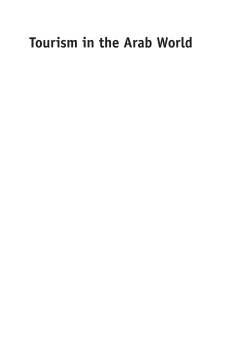
Additional Information
Book Details
Abstract
This book is the first to explore Arabic tourism from a business viewpoint, rather than taking a sociological, anthropological or political stance. It focuses on business planning, management and marketing destinations in the Arab World, which are topics crucial for industry stakeholders and which have previously been neglected in the tourism literature. The book examines similarities and differences in the emergence and development of the tourism industry in countries across the Arab world as well as its inbound and outbound travel flows. It analyses several different aspects of Arabic tourism including tourism policy, organisation and planning, tourism product development, destination marketing and consumer behaviour. This volume will be of interest to postgraduate students and researchers of tourism studies, business and Middle Eastern studies.
An insightful and much-needed textbook, a welcome gesture from an Arab perspective. It simply tackles the problems of demarcation between the Arab world and the rest of the Muslim world with narratives that open the eyes of outsiders to the wealth of tourism to be found within the Arab civilisation.
In today’s competitive and culturally diverse global village it is encouraging to see the first volume that explores tourism in the Arab world. This unique volume provides an interesting analysis of this multifaceted, complex and sometimes controversial subject. This is a timely volume that is a must-read for all involved in the tourism industry. It provides a comprehensive overview of emerging research agendas and perceptive insights into contemporary issues.
An authoritative business-based resource book, penned by international authors in the know, the volume unveils covert tenets of the Arab tourism world whose development potentials are poorly understood, let alone sustainably realized. Insightfully pragmatic.
Hamed Almuhrzi is Assistant Professor and Head of Department, International Business Administration, Rustaq College of Applied Sciences, Ministry of Higher Education, Oman. His research interests include visitor studies, visitor experience, heritage and cultural tourism, Arab tourism, Muslim tourism and interpretation.
Hafidh Alriyami is Lecturer in International Business Administration, Rustaq College of Applied Sciences, Ministry of Higher Education, Oman. His research focuses on Muslim tourism, Arab tourism, sustainable tourism and the psychology of tourist behaviour.
Noel Scott is Professor and Deputy Director at Griffith Institute for Tourism, Griffith University, Australia. His research interests are experience design, Arab tourism, Muslim tourism, destination marketing and management.
Table of Contents
| Section Title | Page | Action | Price |
|---|---|---|---|
| Contents | v | ||
| Contributors | xi | ||
| 1 Introduction | 1 | ||
| 2 Tourism Development and Governance: An Overview of Arab Countries | 16 | ||
| 3 Developing Event Tourism in Saudi Arabia: Opportunities and Challenges | 33 | ||
| 4 Women Empowerment in the Arab Tourism Sector: Case Study of the Sultanate ofOman | 56 | ||
| 5 Tourism Sustainability Planning in the ‘Arab World’: Insights from Egypt | 70 | ||
| 6 Planning for Tourism in Oman based on Lessons from Dubai: Overviewing Economic, Environmental and Sociocultural Impacts | 87 | ||
| 7 The UAE: A Disneyland in the Desert | 104 | ||
| 8 Halal Tourism: Definitions and Developments | 118 | ||
| 9 Brand Expectation and Authentic Service Experiences in the Hotel Industry in Dubai | 131 | ||
| 10 Tunisian Tourism: At the Eye of an Arab Spring Storm | 145 | ||
| 11 Destination Brands Dubai and Abu Dhabi: Bitter Rivalry or Strategic Partnership? | 161 | ||
| 12 Marketing the Middle East in Times of Political Instability – The Case of Jordan | 175 | ||
| 13 Representation of Egyptian Bedouins in English-Language Tourist Brochures | 188 | ||
| 14 The Business of Hajj | 207 | ||
| 15 Understanding the Motivations and Expectations of Arab Visitors at the Gold Coast, Australia | 220 | ||
| 16 The Role of Islam in Omani Tourists’ Travel Behaviour | 235 | ||
| 17 Exploring the Experiences of International and Domestic Visitors at the Egyptian Museum in Cairo | 254 | ||
| 18 Conclusion | 274 | ||
| Index | 281 |
